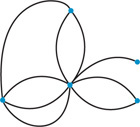B Apply
-
- Open-Ended Sketch a polyhedron whose faces are all rectangles. Label the lengths of its edges.
- Use graph paper to draw two different nets for the polyhedron.
-
For the figure shown below, sketch each of following.

- a horizontal cross section
- a vertical cross section that contains the vertical line of symmetry
- Reasoning Can you find a cross section of a cube that forms a triangle? Explain.
- Reasoning Suppose the number of faces in a certain polyhedron is equal to the number of vertices. Can the polyhedron have nine edges? Explain.
Visualization Draw and describe a cross section formed by a plane intersecting the cube as follows.

- The plane is tilted and intersects the left and right faces of the cube.
- The plane contains the red edges of the cube.
- The plane cuts off a corner of the cube.
Visualization A plane region that revolves completely about a line sweeps out a solid of revolution. Use the sample to help you describe the solid of revolution you get by revolving each region about line l.
Sample: Revolve the rectangular region about the line l. You get a cylinder as the solid of revolution.


-

-

-

-
Think About a Plan Some balls are made from panels that suggest polygons. A soccer ball suggests a polyhedron with 20 regular hexagons and 12 regular pentagons. How many vertices does this polyhedron have?

- How can you determine the number of edges in a solid if you know the types of polygons that form the faces?
- What relationship can you use to find the number of vertices?
Euler's Formula
Table of Contents
- 6-1 The Polygon Angle-Sum Theorems
- 6-2 Properties of Parallelograms
- 6-3 Proving That a Quadrilateral Is a Parallelogram
- 6-4 Properties of Rhombuses, Rectangles, and Squares
- 6-5 Conditions for Rhombuses, Rectangles, and Squares
- 6-6 Trapezoids and Kites
- 6-7 Polygons in the Coordinate Plane
- 6-8 and 6-9 Coordinate Geometry and Coordinate Proofs







